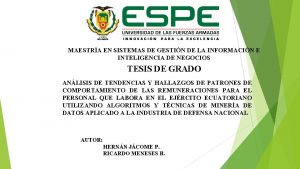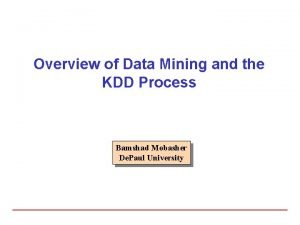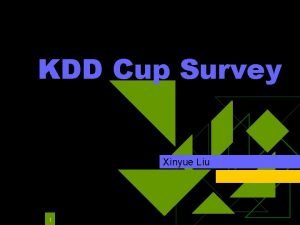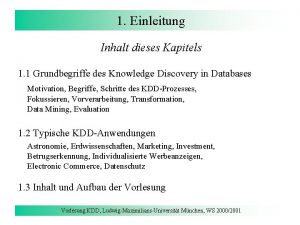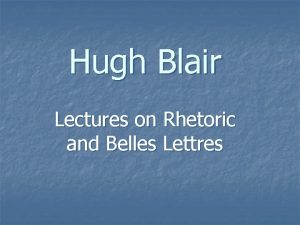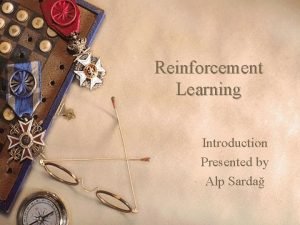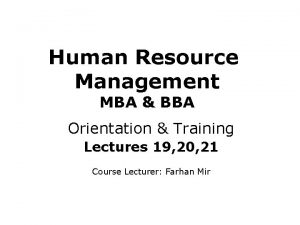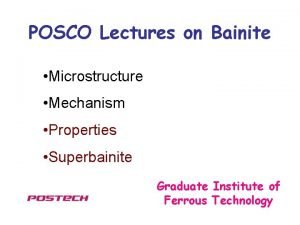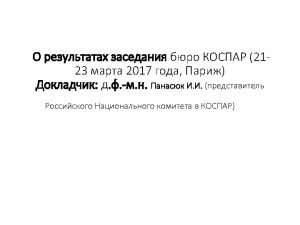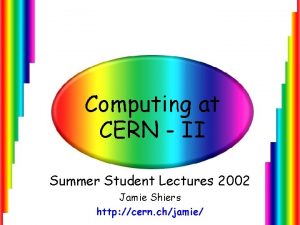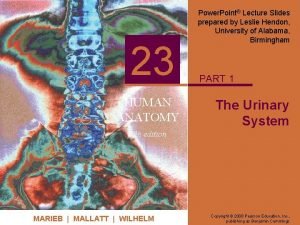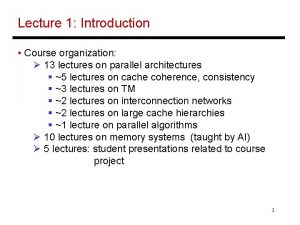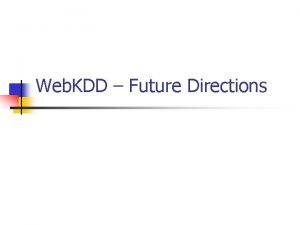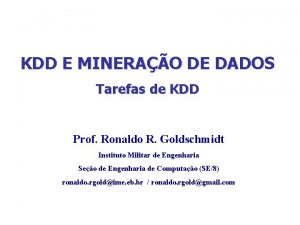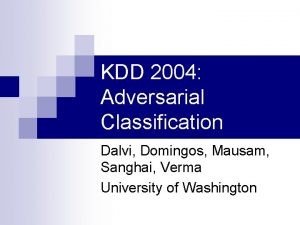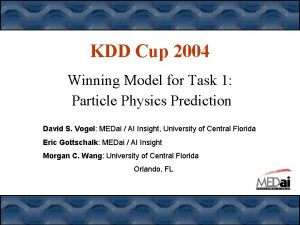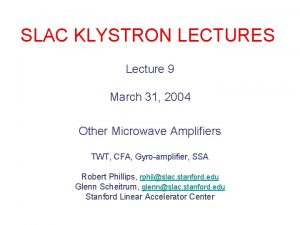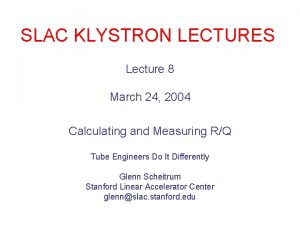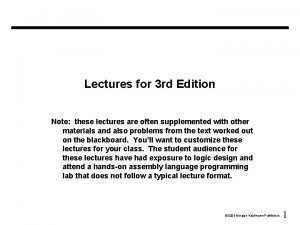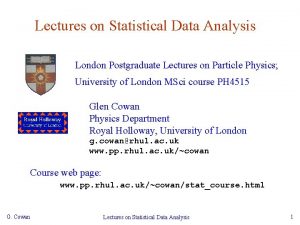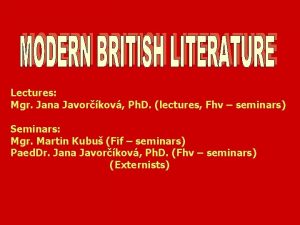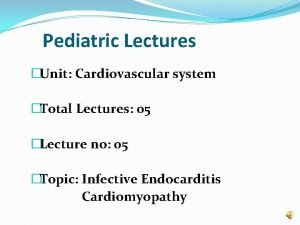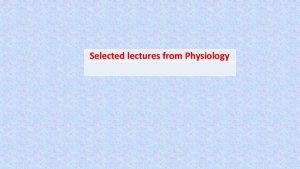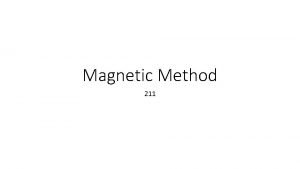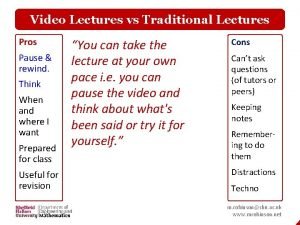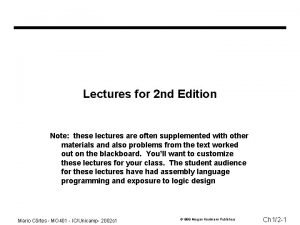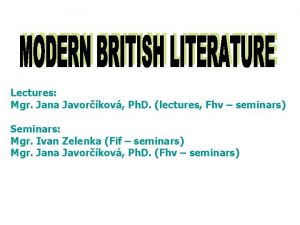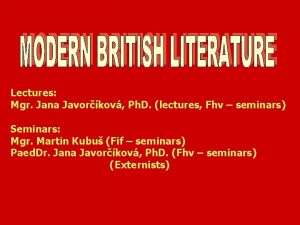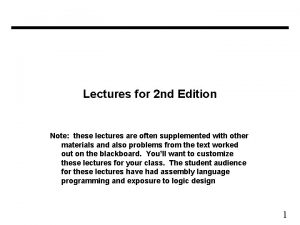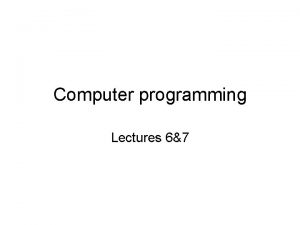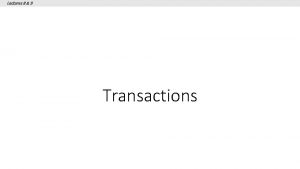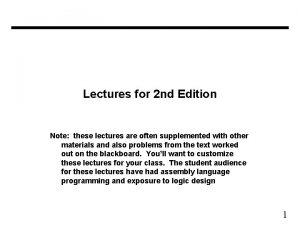KDD 2004 Lectures n n n March 49












![Normalization in [0, 1] Problem: If non-normalized variables are used the maximum distance between Normalization in [0, 1] Problem: If non-normalized variables are used the maximum distance between](https://slidetodoc.com/presentation_image/7cc05adbc8a8d27b3c935492dd6444e5/image-13.jpg)







































- Slides: 52

KDD --- 2004 Lectures n n n March 4+9: Introduction to KDD March 11: Association Rule Mining March 23: Similarity Assessment March 25: Clustering and UHDM 2 March 30: Data Warehouses and OLAP Han, Kamber, Eick: Object Similarity & Clustering for COSC 6340 1

Clustering and Similarity Assessment ©Jiawei Han and Micheline Kamber with major Additions and Modifications by Ch. Eick Organization for COSC 6340: 1. What is Clustering? 2. Object Similarity Assessment 3. K-means/medoid Clustering 4. Grid-based Clustering 5. Work at UH Han, Kamber, Eick: Object Similarity & Clustering for COSC 6340 2

Motivation: Why Clustering? Problem: Identify (a small number of) groups of similar objects in a given (large) set of object. Goals: n Find representatives for homogeneous groups Data Compression n Find “natural” clusters and describe their properties ”natural” Data Types n Find suitable and useful grouping ”useful” Data Classes n Find unusual data object Outlier Detection Han, Kamber, Eick: Object Similarity & Clustering for COSC 6340 4

Examples of Clustering Applications n Plant/Animal Classification n Book Ordering n Cloth Sizes n Fraud Detection (Find outlier) Han, Kamber, Eick: Object Similarity & Clustering for COSC 6340 5

Requirements of Clustering in Data Mining n Scalability n Ability to deal with different types of attributes n Discovery of clusters with arbitrary shape n Minimal requirements for domain knowledge to determine input parameters n Able to deal with noise and outliers n Insensitive to order of input records n High dimensionality n Incorporation of user-specified constraints n Interpretability and usability Han, Kamber, Eick: Object Similarity & Clustering for COSC 6340 6

Data Structures for Clustering n n Data matrix n (n objects, p attributes) (Dis)Similarity matrix n (nxn) Han, Kamber, Eick: Object Similarity & Clustering for COSC 6340 7

Quality Evaluation of Clusters n n n Dissimilarity/Similarity metric: Similarity is expressed in terms of a normalized distance function d, which is typically metric; typically: d (oi, oj) = 1 - d (oi, oj) There is a separate “quality” function that measures the “goodness” of a cluster. The definitions of similarity functions are usually very different for interval-scaled, boolean, categorical, ordinal and ratio-scaled variables. Weights should be associated with different variables based on applications and data semantics. It is hard to define “similar enough” or “good enough” n the answer is typically highly subjective. Han, Kamber, Eick: Object Similarity & Clustering for COSC 6340 8

Challenges in Obtaining Object Similarity Measures n Many Types of Variables n n n Interval-scaled variables Binary variables and nominal variables Ordinal variables Ratio-scaled variables Objects are characterized by variables belonging to different types (mixture of variables) Han, Kamber, Eick: Object Similarity & Clustering for COSC 6340 9

Case Study: Patient Similarity The following relation is given (with 10000 tuples): Patient(ssn, weight, height, cancer-sev, eye-color, age) n Attribute Domains n n ssn: 9 digits n weight between 30 and 650; mweight=158 sweight=24. 20 n height between 0. 30 and 2. 20 in meters; mheight=1. 52 sheight=19. 2 n cancer-sev: 4=serious 3=quite_serious 2=medium 1=minor n eye-color: {brown, blue, green, grey } n age: between 3 and 100; mage=45 sage=13. 2 Task: Define Patient Similarity Han, Kamber, Eick: Object Similarity & Clustering for COSC 6340 10

Generating a Global Similarity Measure from Single Variable Similarity Measures Assumption: A database may contain up to six types of variables: symmetric binary, asymmetric binary, nominal, ordinal, interval and ratio. 1. Standardize variable and associate similarity measure di with the standardized i-th variable and determine weight wi of the i-th variable. 2. Create the following global (dis)similarity measure d: Han, Kamber, Eick: Object Similarity & Clustering for COSC 6340 11

A Methodology to Obtain a Similarity Matrix 1. Understand Variables 2. Remove (non-relevant and redundant) Variables 3. (Standardize and) Normalize Variables (typically using zscores or variable values are transformed to numbers in [0, 1]) 4. Associate (Dis)Similarity Measure df/df with each Variable 5. Associate a Weight (measuring its importance) with each Variable 6. Compute the (Dis)Similarity Matrix 7. Apply Similarity-based Data Mining Technique (e. g. Clustering, Nearest Neighbor, Multi-dimensional Scaling, …) Han, Kamber, Eick: Object Similarity & Clustering for COSC 6340 12

Interval-scaled Variables n Standardize data using z-scores n Calculate the mean absolute deviation: where n n Calculate the standardized measurement (z-score) Using mean absolute deviation is more robust than using standard deviation Han, Kamber, Eick: Object Similarity & Clustering for COSC 6340 13
![Normalization in 0 1 Problem If nonnormalized variables are used the maximum distance between Normalization in [0, 1] Problem: If non-normalized variables are used the maximum distance between](https://slidetodoc.com/presentation_image/7cc05adbc8a8d27b3c935492dd6444e5/image-13.jpg)
Normalization in [0, 1] Problem: If non-normalized variables are used the maximum distance between two values can be greater than 1. Solution: Normalize interval-scaled variables using where minf denotes the minimum value and maxf denotes the maximum value of the f-th attribute in the data set and s is constant that is choses depending on the similarity measure (e. g. if Manhattan distance is used s is chosen to be 1). Han, Kamber, Eick: Object Similarity & Clustering for COSC 6340 14

Other Normalizations Goal: Limit the maximum distance to 1 n Start using a distance measure df(x, y) n Determine the maximum distance dmaxf that can occur for two values of the f-th attribute (e. g. dmaxf=maxf-minf ). n Define df(x, y)=1 - (df(x, y)/ dmaxf) Advantage: Negative similarities cannot occur. Han, Kamber, Eick: Object Similarity & Clustering for COSC 6340 15

Similarity Between Objects n n Distances are normally used to measure the similarity or dissimilarity between two data objects Some popular ones include: Minkowski distance: where i = (xi 1, xi 2, …, xip) and j = (xj 1, xj 2, …, xjp) are two p-dimensional data objects, and q is a positive integer n If q = 1, d is Manhattan distance Han, Kamber, Eick: Object Similarity & Clustering for COSC 6340 16

Similarity Between Objects (Cont. ) n If q = 2, d is Euclidean distance: n Properties n n n d(i, j) 0 d(i, i) = 0 d(i, j) = d(j, i) d(i, j) d(i, k) + d(k, j) Also one can use weighted distance, parametric Pearson product moment correlation, or other disimilarity measures. Han, Kamber, Eick: Object Similarity & Clustering for COSC 6340 17

Similarity with respect to a Set of Binary Variables n A contingency table for binary data Object j Object i Ignores agreements in O’s Considers agreements in 0’s and 1’s to be equivalent. Han, Kamber, Eick: Object Similarity & Clustering for COSC 6340 18

Similarity between Binary Variable Sets n Example n n n gender is a symmetric attribute the remaining attributes are asymmetric binary let the values Y and P be set to 1, and the value N be set to 0 Han, Kamber, Eick: Object Similarity & Clustering for COSC 6340 19

Nominal Variables n n A generalization of the binary variable in that it can take more than 2 states, e. g. , red, yellow, blue, green Method 1: Simple matching n n m: # of matches, p: total # of variables Method 2: use a large number of binary variables n creating a new binary variable for each of the M nominal states Han, Kamber, Eick: Object Similarity & Clustering for COSC 6340 20

Ordinal Variables n An ordinal variable can be discrete or continuous n order is important (e. g. UH-grade, hotel-rating) n Can be treated like interval-scaled n n n replacing xif by their rank: map the range of each variable onto [0, 1] by replacing the f-th variable of i-th object by compute the dissimilarity using methods for intervalscaled variables Han, Kamber, Eick: Object Similarity & Clustering for COSC 6340 21

Ratio-Scaled Variables n n Ratio-scaled variable: a positive measurement on a nonlinear scale, approximately at exponential scale, such as Ae. Bt or Ae-Bt Methods: n treat them like interval-scaled variables — not a good choice! (why? ) n apply logarithmic transformation yif = log(xif) n treat them as continuous ordinal data treat their rank as interval-scaled. Han, Kamber, Eick: Object Similarity & Clustering for COSC 6340 22

Case Study --- Normalization Patient(ssn, weight, height, cancer-sev, eye-color, age) n Attribute Relevance: ssn no; eye-color minor; other major n Attribute Normalization: n n n ssn remove! weight between 30 and 650; mweight=158 sweight=24. 20; transform to zweight= (xweight-158)/24. 20 (alternatively, zweight=(xweight-30)/620)); height normalize like weight! cancer_sev: 4=serious 3=quite_serious 2=medium 1=minor; transform 4 to 1, 3 to 2/3, 2 to 1/3, 1 to 0 and then normalize like weight! age: normalize like weight! Han, Kamber, Eick: Object Similarity & Clustering for COSC 6340 23

Case Study --- Weight Selection and Similarity Measure Selection Patient(ssn, weight, height, cancer-sev, eye-color, age) n For normalized weight, height, cancer_sev, age values use Manhattan distance function; e. g. : dweight(w 1, w 2)= 1 - | ((w 1 -158)/24. 20 ) - ((w 2 -158)/24. 20) | n For eye-color use: deye-color(c 1, c 2)= if c 1=c 2 then 1 else 0 n Weight Assignment: 0. 2 for eye-color; 1 for all others Final Solution --- chosen Similarity Measure d: Let o 1=(s 1, w 1, h 1, cs 1, e 1, a 1) and o 2=(s 2, w 2, h 2, cs 2, e 2, a 2) d(o 1, o 2): = (dweight(w 1, w 2) + dheight(h 1, h 2) + dcancersev(cs 1, cs 2) + dage(a 1, a 2) + 0. 2* deye-color(e 1, e 2) ) /4. 2 Han, Kamber, Eick: Object Similarity & Clustering for COSC 6340 24

Major Clustering Approaches n Partitioning algorithms: Construct various partitions and then evaluate them by some criterion n Hierarchy algorithms: Create a hierarchical decomposition of the set of data (or objects) using some criterion n Density-based: based on connectivity and density functions n Grid-based: based on a multiple-level granularity structure n Model-based: A model is hypothesized for each of the clusters and the idea is to find the best fit of that model to each other Han, Kamber, Eick: Object Similarity & Clustering for COSC 6340 25

Partitioning Algorithms: Basic Concept n n Partitioning method: Construct a partition of a database D of n objects into a set of k clusters Given a k, find a partition of k clusters that optimizes the chosen partitioning criterion n Global optimal: exhaustively enumerate all partitions n Heuristic methods: k-means and k-medoids algorithms n k-means (Mac. Queen’ 67): Each cluster is represented by the center of the cluster n k-medoids or PAM (Partition around medoids) (Kaufman & Rousseeuw’ 87): Each cluster is represented by one of the objects in the cluster Han, Kamber, Eick: Object Similarity & Clustering for COSC 6340 26

The K-Means Clustering Method n Given k, the k-means algorithm is implemented in 4 steps: n Partition objects into k nonempty subsets n Compute seed points as the centroids of the clusters of the current partition. The centroid is the center (mean point) of the cluster. n Assign each object to the cluster with the nearest seed point. n Go back to Step 2, stop when no more new assignment. Han, Kamber, Eick: Object Similarity & Clustering for COSC 6340 27

The K-Means Clustering Method n Example Han, Kamber, Eick: Object Similarity & Clustering for COSC 6340 28

Comments on the K-Means Method n Strength n n n Relatively efficient: O(tkn), where n is # objects, k is # clusters, and t is # iterations. Normally, k, t << n. Often terminates at a local optimum. The global optimum may be found using techniques such as: deterministic annealing and genetic algorithms Weakness n Applicable only when mean is defined, then what about categorical data? n Need to specify k, the number of clusters, in advance n Unable to handle noisy data and outliers n Not suitable to discover clusters with non-convex shapes Han, Kamber, Eick: Object Similarity & Clustering for COSC 6340 29

PAM (Partitioning Around Medoids) (1987) n PAM (Kaufman and Rousseeuw, 1987), built in Splus n Use real object to represent the cluster n n n Select k representative objects arbitrarily For each pair of non-selected object h and selected object i, calculate the total swapping cost TCih For each pair of i and h, n n n If TCih < 0, i is replaced by h Then assign each non-selected object to the most similar representative object repeat steps 2 -3 until there is no change Han, Kamber, Eick: Object Similarity & Clustering for COSC 6340 30

PAM Clustering: Total swapping cost TCih= j. Cjih j t t j i h i h i t h j t Han, Kamber, Eick: Object Similarity & Clustering for COSC 6340 31

CLARANS (“Randomized” CLARA) (1994) n CLARANS (A Clustering Algorithm based on Randomized Search) (Ng and Han’ 94) n n n CLARANS draws sample of neighbors dynamically The clustering process can be presented as searching a graph where every node is a potential solution, that is, a set of k medoids If the local optimum is found, CLARANS starts with new randomly selected node in search for a new local optimum It is more efficient and scalable than both PAM and CLARA Focusing techniques and spatial access structures may further improve its performance (Ester et al. ’ 95) Han, Kamber, Eick: Object Similarity & Clustering for COSC 6340 32

Grid-Based Clustering Method n Using multi-resolution grid data structure n Several interesting methods n n STING (a STatistical INformation Grid approach) by Wang, Yang and Muntz (1997) Wave. Cluster by Sheikholeslami, Chatterjee, and Zhang (VLDB’ 98) n n A multi-resolution clustering approach using wavelet method CLIQUE: Agrawal, et al. (SIGMOD’ 98) Han, Kamber, Eick: Object Similarity & Clustering for COSC 6340 33

STING: A Statistical Information Grid Approach n n n Wang, Yang and Muntz (VLDB’ 97) The spatial area is divided into rectangular cells There are several levels of cells corresponding to different levels of resolution Han, Kamber, Eick: Object Similarity & Clustering for COSC 6340 34

STING: A Statistical Information Grid Approach (2) n n n Each cell at a high level is partitioned into a number of smaller cells in the next lower level Statistical info of each cell is calculated and stored beforehand is used to answer queries Parameters of higher level cells can be easily calculated from parameters of lower level cell n count, mean, s, min, max n type of distribution—normal, uniform, etc. Use a top-down approach to answer spatial data queries Start from a pre-selected layer—typically with a small number of cells For each cell in the current level compute the confidence interval Han, Kamber, Eick: Object Similarity & Clustering for COSC 6340

STING: A Statistical Information Grid Approach (3) n n n Remove the irrelevant cells from further consideration When finish examining the current layer, proceed to the next lower level Repeat this process until the bottom layer is reached Advantages: n Query-independent, easy to parallelize, incremental update n O(K), where K is the number of grid cells at the lowest level Disadvantages: n All the cluster boundaries are either horizontal or vertical, and no diagonal boundary is detected Han, Kamber, Eick: Object Similarity & Clustering for COSC 6340

CLIQUE (Clustering In QUEst) n Agrawal, Gehrke, Gunopulos, Raghavan (SIGMOD’ 98). n Automatically identifying subspaces of a high dimensional data space that allow better clustering than original space n CLIQUE can be considered as both density-based and gridbased n It partitions each dimension into the same number of equal length interval n It partitions an m-dimensional data space into nonoverlapping rectangular units n A unit is dense if the fraction of total data points contained in the unit exceeds the input model parameter n A cluster is a maximal set of connected dense units within a subspace Han, Kamber, Eick: Object Similarity & Clustering for COSC 6340 37

CLIQUE: The Major Steps n n n Partition the data space and find the number of points that lie inside each cell of the partition. Identify the subspaces that contain clusters using the Apriori principle Identify clusters: n n n Determine dense units in all subspaces of interests Determine connected dense units in all subspaces of interests. Generate minimal description for the clusters n Determine maximal regions that cover a cluster of connected dense units for each cluster n Determination of minimal cover for each cluster Han, Kamber, Eick: Object Similarity & Clustering for COSC 6340 38

30 40 50 20 30 40 50 age 60 Vacation =3 Vacation (week) 0 1 2 3 4 5 6 7 Salary (10, 000) 0 1 2 3 4 5 6 7 20 age 60 a al ry S Han, Kamber, Eick: Object Similarity & Clustering for COSC 6340 30 50 age 39

Strength and Weakness of CLIQUE n n Strength n It automatically finds subspaces of the highest dimensionality such that high density clusters exist in those subspaces n It is insensitive to the order of records in input and does not presume some canonical data distribution n It scales linearly with the size of input and has good scalability as the number of dimensions in the data increases Weakness n The accuracy of the clustering result may be degraded at the expense of simplicity of the method Han, Kamber, Eick: Object Similarity & Clustering for COSC 6340 40

Work at UH related to Similarity Assessment and Clustering n n n Creating Environments for Database Clustering; problems related to Multi-relational Data Mining [ER 04]. Distance Function Learning [EVR 03] Supervised Clustering [EZZ 04] Using Clustering to Enhance Classifiers [ICDM 03], [ECAI 04], [PKDD 04] not discussed Using SQL Queries for Data Summarization [KDD 96]; [RYU 98]; not discussed Work at UH Han, Kamber, Eick: Object Similarity & Clustering for COSC 6340 41

CAL-FULL/UH Database Clustering Similarity Assessment Environments Library of clustering algorithms Object View Data Extraction Tool DBMS Clustering Tool User Interface Training Date A set of clusters Similarity measure Similarity Measure Tool Default choices and domain information Learning Tool Library of similarity measures Type and weight information Work at UH Han, Kamber, Eick: Object Similarity & Clustering for COSC 6340 42

Prototypes of Similarity Assessment Tools n n n Prototype 1 (CAL State Fullerton): Supported the interactive definition of similarity measures; knowledge representation format does not rely on modular units; provides a nearest neighbor clustering algorithm for database clustering; functions were supported outside a DBMS Prototype 2 (UH 2002): Similarity measures are defined using a special language (not interactively); tool supports modular units and functions are provided using a Java/SQL-Server 2000 framework; functions were partially moved inside a DBMS (although some are still inside Java); analysis results are stored in the database and therefore available for further analysis. Prototype 3 (UH): Learn Distance Functions for Classification Problems. Currently Investigated! Work at UH Han, Kamber, Eick: Object Similarity & Clustering for COSC 6340 43

Work at UH Objectives Supervised Clustering: Maximize Cluster Purity while keeping the number of clusters low.

Research Goals Supervised Clustering n n Develop representative-based supervised clustering algorithms. Show the benefits of supervised clustering in case studies that center on summary generation, distance function learning, and classification. Work at UH Han, Kamber, Eick: Object Similarity & Clustering for COSC 6340 45

Work at UH What is a good object distance function q for supervised similarity assessment? n n n Objective: Learn good distance functions for classification tasks. Our approach: Apply a clustering algorithm with the distance function q to be evaluated that returns a predetermined number of clusters k. The more pure the obtained clusters are the better is the quality of q. Our goal is to learn the weights of an object distance function q such that all the clusters are pure (or as pure is possible); for more details see [ERV 03] Paper. 46 Han, Kamber, Eick: Object Similarity & Clustering for COSC 6340

Work at UH Idea: Coevolving Clusters and Similarity Functions Reinforcement Learning Similarity Function Clusters X Clustering q(X) Clustering Evaluation q(X): =percentage_of_minority_examples + Goodness of The Similarity Function penalty(k): = If k c then 0 else sqrt((k-c)/n)) with k: = number of clusters generated n: = number of objects in the dataset c: = number of classes in the dataset Han, Kamber, Eick: Object Similarity & Clustering for COSC 6340 47

Idea CR*-Approach Let Y be a clustering algorithm and Error(q, O)=Error’(Y(q, O)) an error function that measures class purity in clusters, class coverage, and assigns a penalty for large numbers of clusters. While not done do 1. Cluster with respect to (q, O) receiving clusters C and report Error’(Y(q, O)) 2. If Error’(Y(q, O)) is small enough stop reporting the error, C, and q 3. For each cluster determine majority class Cluster 4. For each ce. C adjust weights wj locally xo X x: =examples belonging to majority class o: = non-majority-class examples o o x x Decrease weight for modular unit Cluster Idea: Move examples of the majority class closer to each other Work at UH Xx xx o o o Increase weight for modular unit 48

Work at UH Weight Adjustment within a Cluster Let wi be the current weight of the i-th modular unit Let si be the average absolute deviation for the examples that belong to the cluster with respect to fi Let mi be the average absolute deviation for the examples of the cluster that belong to the majority class with respect to fi Learning: Then weights are adjusted as follows with respect to a particular cluster: wi’=wi+ (si – mi) *a or better wi’=wi+ wi*min(max(-b, (si – mi) *a), b) with a being the learning rate and b maximal adjustment (e. g. if b=0. 2 a weight can be maximally increased/decreased by 20%) per weight per cluster. Remark: If the cluster is ‘pure’ or does not contain 2 or more elements of a particular class, no weight adjustment takes place. Han, Kamber, Eick: Object Similarity & Clustering for COSC 6340 49

Summary: Problems and Challenges for Clustering n n n Considerable progress has been made in scalable clustering methods n Partitioning: k-means, k-medoid, CLARANS, EM n Hierarchical: BIRCH, CURE n Density-based: DBSCAN, CLIQUE, OPTICS n Grid-based: STING, Wave. Cluster n Model-based: Autoclass, Denclue, Cobweb Current clustering techniques do not address all the requirements adequately Constraint-based clustering analysis: Constraints exist in data space (bridges and highways) or in user queries Han, Kamber, Eick: Object Similarity & Clustering for COSC 6340 50

Summary Object Similarity & Clustering n n Cluster analysis groups objects based on their similarity and has wide applications Appropriate similarity measures have to be chosen for various types of variables and combined into a global similarity measure. Clustering algorithms can be categorized into partitioning methods, hierarchical methods, density-based methods, grid-based methods, and model-based methods Methods to measure, compute, and learn object similarity are quite important, not only for clustering, but also for nearest neighbor approaches, information retrieval in general, and for data visualization. Han, Kamber, Eick: Object Similarity & Clustering for COSC 6340 51

References (1) n n n n n R. Agrawal, J. Gehrke, D. Gunopulos, and P. Raghavan. Automatic subspace clustering of high dimensional data for data mining applications. SIGMOD'98 M. R. Anderberg. Cluster Analysis for Applications. Academic Press, 1973. M. Ankerst, M. Breunig, H. -P. Kriegel, and J. Sander. Optics: Ordering points to identify the clustering structure, SIGMOD’ 99. P. Arabie, L. J. Hubert, and G. De Soete. Clustering and Classification. World Scietific, 1996 M. Ester, H. -P. Kriegel, J. Sander, and X. Xu. A density-based algorithm for discovering clusters in large spatial databases. KDD'96. M. Ester, H. -P. Kriegel, and X. Xu. Knowledge discovery in large spatial databases: Focusing techniques for efficient class identification. SSD'95. D. Fisher. Knowledge acquisition via incremental conceptual clustering. Machine Learning, 2: 139 -172, 1987. D. Gibson, J. Kleinberg, and P. Raghavan. Clustering categorical data: An approach based on dynamic systems. In Proc. VLDB’ 98. S. Guha, R. Rastogi, and K. Shim. Cure: An efficient clustering algorithm for large databases. SIGMOD'98. A. K. Jain and R. C. Dubes. Algorithms for Clustering Data. Printice Hall, 1988. Han, Kamber, Eick: Object Similarity & Clustering for COSC 6340 52

References (2) n n n n n L. Kaufman and P. J. Rousseeuw. Finding Groups in Data: an Introduction to Cluster Analysis. John Wiley & Sons, 1990. E. Knorr and R. Ng. Algorithms for mining distance-based outliers in large datasets. VLDB’ 98. G. J. Mc. Lachlan and K. E. Bkasford. Mixture Models: Inference and Applications to Clustering. John Wiley and Sons, 1988. P. Michaud. Clustering techniques. Future Generation Computer systems, 13, 1997. R. Ng and J. Han. Efficient and effective clustering method for spatial data mining. VLDB'94. E. Schikuta. Grid clustering: An efficient hierarchical clustering method for very large data sets. Proc. 1996 Int. Conf. on Pattern Recognition, 101 -105. G. Sheikholeslami, S. Chatterjee, and A. Zhang. Wave. Cluster: A multi-resolution clustering approach for very large spatial databases. VLDB’ 98. W. Wang, Yang, R. Muntz, STING: A Statistical Information grid Approach to Spatial Data Mining, VLDB’ 97. T. Zhang, R. Ramakrishnan, and M. Livny. BIRCH : an efficient data clustering method for very large databases. SIGMOD'96. Han, Kamber, Eick: Object Similarity & Clustering for COSC 6340 53
 Poland national anthem lyrics
Poland national anthem lyrics What is data mining and data warehousing
What is data mining and data warehousing Proceso kdd
Proceso kdd Kdd process
Kdd process Kdd task manager
Kdd task manager Proceso kdd
Proceso kdd Kdd cup 1998 solution
Kdd cup 1998 solution Kdd fayyad
Kdd fayyad Diatermi yanığı
Diatermi yanığı Metodologia kdd
Metodologia kdd Frcr physics lectures
Frcr physics lectures Step wise project planning
Step wise project planning Hugh blair lectures on rhetoric
Hugh blair lectures on rhetoric Reinforcement learning lectures
Reinforcement learning lectures Bba lectures
Bba lectures Cdeep lectures
Cdeep lectures Theory and practice of translation lectures
Theory and practice of translation lectures What is aerodynamics
What is aerodynamics Ota resident lectures
Ota resident lectures Utilities and energy lecture
Utilities and energy lecture Bhadeshia lectures
Bhadeshia lectures Bureau of lectures
Bureau of lectures Data mining lectures
Data mining lectures Philosophy of fine arts
Philosophy of fine arts Heel effect
Heel effect Cell and molecular biology lectures
Cell and molecular biology lectures Cern summer student lectures
Cern summer student lectures Medical emergency student lectures
Medical emergency student lectures Oral communication 3 lectures text
Oral communication 3 lectures text Theory of translation lectures
Theory of translation lectures Theory of translation lectures
Theory of translation lectures Anatomy lectures powerpoint
Anatomy lectures powerpoint Introduction to web engineering
Introduction to web engineering Yelena bogdan md
Yelena bogdan md 13 lectures
13 lectures Slagle lecture
Slagle lecture Medicinal chemistry lectures
Medicinal chemistry lectures Nuclear medicine lectures
Nuclear medicine lectures Cs106b lectures
Cs106b lectures Radio astronomy lectures
Radio astronomy lectures Pathology lectures for medical students
Pathology lectures for medical students Hematology
Hematology C programming lectures
C programming lectures Power system lectures
Power system lectures Rick trebino
Rick trebino Digital logic design lectures
Digital logic design lectures Do words have power
Do words have power Cs614 short lectures
Cs614 short lectures Comsats virtual campus lectures
Comsats virtual campus lectures Reinforcement learning lectures
Reinforcement learning lectures Theory of translation lectures
Theory of translation lectures Orthopedic ppt lectures
Orthopedic ppt lectures Cs106b lectures
Cs106b lectures


